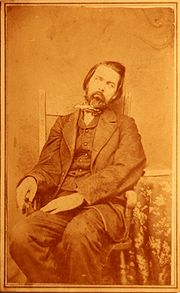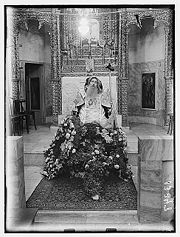
Post-mortem photography
Encyclopedia

History and popularity
The invention of the daguerreotypeDaguerreotype
The daguerreotype was the first commercially successful photographic process. The image is a direct positive made in the camera on a silvered copper plate....
in 1839 made portraiture much more commonplace, as many of those who were unable to afford the commission of a painted portrait could afford to sit for a photography
Photography
Photography is the art, science and practice of creating durable images by recording light or other electromagnetic radiation, either electronically by means of an image sensor or chemically by means of a light-sensitive material such as photographic film...
session. This cheaper and quicker method also provided the middle class with a means for memorializing dead loved ones.
These photographs served less as a reminder of mortality than as a keepsake to remember the deceased. This was especially common with infants and young children; Victorian era
Victorian era
The Victorian era of British history was the period of Queen Victoria's reign from 20 June 1837 until her death on 22 January 1901. It was a long period of peace, prosperity, refined sensibilities and national self-confidence...
childhood mortality rates were extremely high, and a post-mortem photograph might have been the only image of the child the family ever had. The later invention of the carte de visite
Carte de visite
The carte de visite was a type of small photograph which was patented in Paris, France by photographer André Adolphe Eugène Disdéri in 1854, although first used by Louis Dodero...
, which allowed multiple prints to be made from a single negative, meant that copies of the image could be mailed to relatives.
The practice eventually peaked in popularity around the end of the 19th century and died out as "snapshot" photography became more commonplace, although a few examples of formal memorial portraits were still being produced well into the 20th century.
Evolving style

Coffin
A coffin is a funerary box used in the display and containment of dead people – either for burial or cremation.Contemporary North American English makes a distinction between "coffin", which is generally understood to denote a funerary box having six sides in plan view, and "casket", which...
. The subject is usually depicted so as to seem in a deep sleep, or else arranged to appear more lifelike. Children were often shown in repose on a couch or in a crib, sometimes posed with a favorite toy or other plaything. It was not uncommon to photograph very young children with a family member, most frequently the mother. Adults were more commonly posed in chairs or even braced on specially-designed frames. Flowers were also a common prop in post-mortem photography of all types.
The effect of life was sometimes enhanced by either propping the subject's eyes open or painting pupils onto the photographic print, and many early images (especially tintype
Tintype
Tintype, also melainotype and ferrotype, is a photograph made by creating a direct positive on a sheet of iron metal that is blackened by painting, lacquering or enamelling and is used as a support for a collodion photographic emulsion....
s and ambrotype
Ambrotype
right|thumb|Many ambrotypes were made by unknown photographers, such as this American example of a small girl holding a flower, circa 1860. Because of their fragility ambrotypes were held in folding cases much like those used for [[daguerreotype]]s...
s) have a rosy tint added to the cheeks of the corpse.
Later examples show less effort at a lifelike appearance, and often show the subject in a coffin. Some very late examples show the deceased in a coffin with a large group of funeral attendees; this type of photograph was especially popular in Europe and less common in the United States.
Post-mortem photography is still practiced in some areas of the world, such as Eastern Europe. Photographs, especially depicting persons who were considered to be very holy lying in their coffins are still circulated among faithful Eastern Catholic, Eastern Orthodox and Oriental Orthodox Christians.
A variation of the memorial portrait involves photographing the family with a shrine (usually including a living portrait) dedicated to the deceased.
Responses in contemporary photography
As the common practice of post-mortem photography in North America and Western Europe has largely ceased, the portrayal of such images has become increasingly seen as vulgar, sensationalistic and taboo. This is in marked contrast to the beauty and sensitivity perceived in the older tradition, indicating a cultural shift that may reflect wider social discomfort with death. Notably, however, the photographs of a number of contemporary artists imply a dialogue that helps illuminate the intent of the early works.Andres Serrano
Andres Serrano
Andres Serrano is an American photographer and artist who has become notorious through his photos of corpses and his use of feces and bodily fluids in his work, notably his controversial work "Piss Christ", a red-tinged photograph of a crucifix submerged in a glass container of what was purported...
's controversial "corpse" series presents morgue photographs of the victims of violent death in the manner of beautified portraits.
Somewhat similarly, the Mexican tabloid photographer Enrique Metinides
Enrique Metinides
Jaralambos Enrique Metinides Tsironides is a Mexican photographer known for his stark and often grisly depictions of life in Mexico City...
—known for his stark and often grisly depictions of life in Mexico City
Mexico City
Mexico City is the Federal District , capital of Mexico and seat of the federal powers of the Mexican Union. It is a federal entity within Mexico which is not part of any one of the 31 Mexican states but belongs to the federation as a whole...
—documents crime scene victims using an unexpected compositionally rich aesthetic that has seen his work exhibited to positive critical response in galleries worldwide. Joel-Peter Witkin
Joel-Peter Witkin
Joel-Peter Witkin is an American photographer who lives in Albuquerque, New Mexico. His work often deals with such themes as death, corpses , and various outsiders such as dwarfs, transsexuals, hermaphrodites, and physically deformed people...
does similar work.
Irish photographer Maeve Berry
Maeve Berry
Maeve Berry is an award-winning Irish freelance photographer. Berry works as both a commercial and fine art photographer and is represented in London by Diemar/Noble Photography....
finds an aesthetic compromise by capturing the burning embers of bodies within the funeral crematorium.
Recently Lyn Hagan
Lyn Hagan
Lyn Hagan is a Newcastle based writer and artist, also founding director of LifeInSpace. Her work principally tries to negotiate and transcend established ideas of theatricality and aesthetics...
has produced a series of hand embroidered portraits of the children in Paul Freckers collection. These reflect a fascination in how people react to impermanence and how such photos were "a means of capturing the image of the person in one last futile gesture that denies their loss whilst at the same time admitting it totally".

